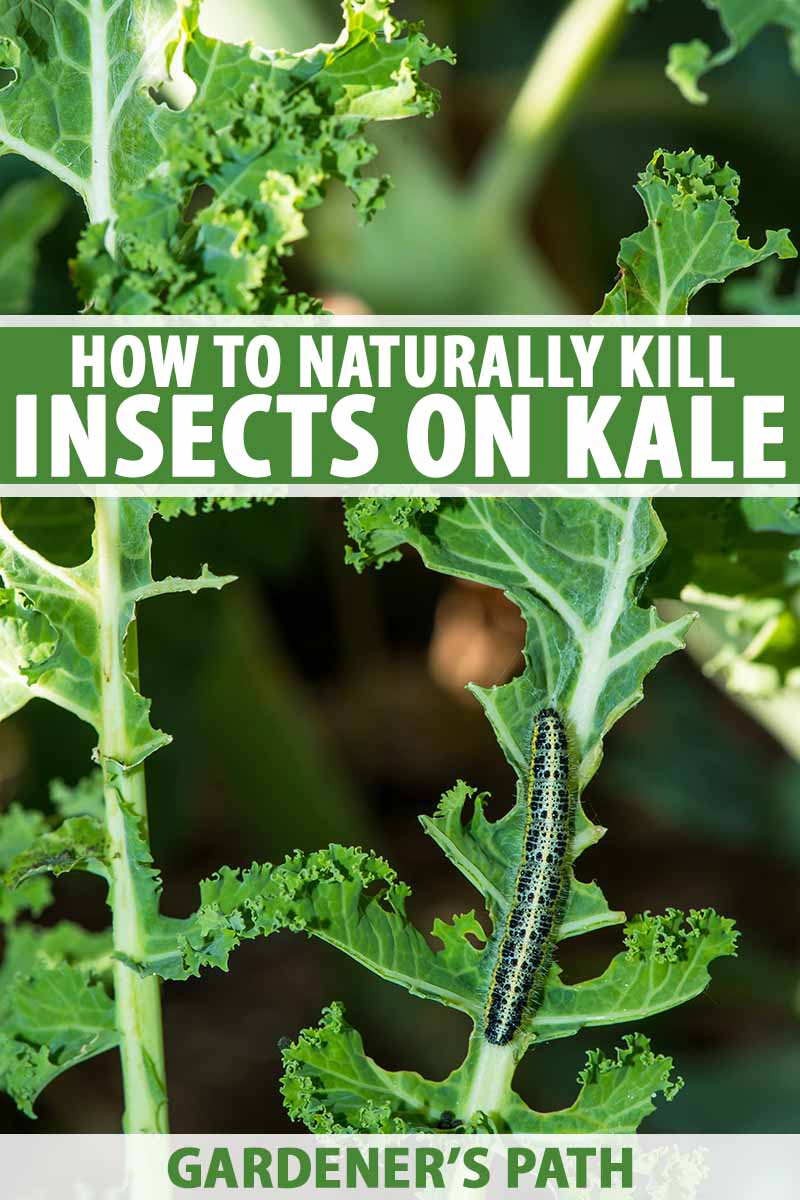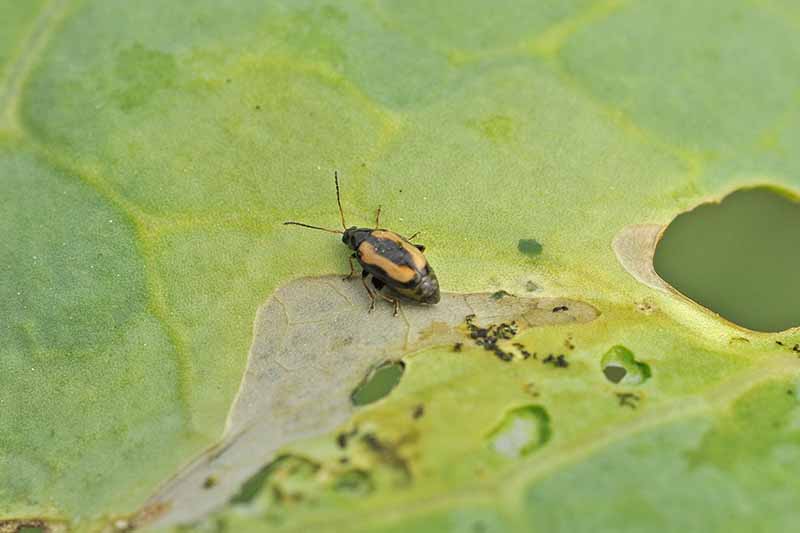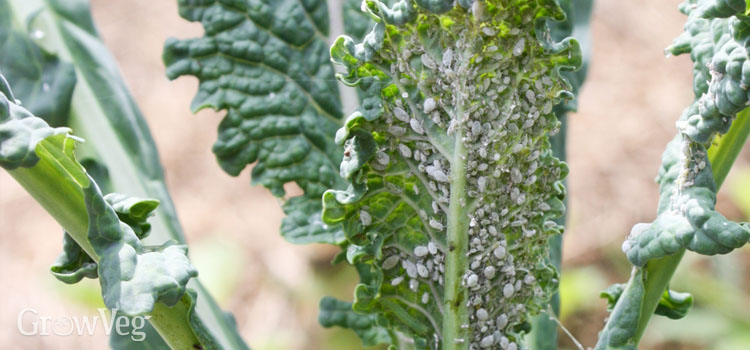Insecticide For Kale
When insects attack your kale plants, you’ll want to fight back. Fortunately, there are natural ways to kill the many different insect pests that plague these greens.
Once I’ve planted my kale and watched the leaves grow, I’m not exactly thrilled to see big chewed holes or lots of little bites. But I realize this is just a part of gardening.

We link to vendors to help you find relevant products. If you buy from one of our links, we may earn a commission.
The first thing to do when you spot insect damage on your kale is to identify the pest that’s causing it. Even if you don’t see the bug itself, the type of bites on the leaves can serve as clues.
Common Kale Pests and How to Control Them
- Aphids (Aphididae Family)
- Flea Beetles (Chrysomelidae Family)
- Harlequin Bug (Murgantia histrionica)
- Imported Cabbage worm (Pieris rapae)
- Keeping Your Kale Plants Pest Free
Continue reading to learn more about pest identification and control.
Aphids (Aphididae family)
Aphids are a family of small insects with soft bodies and sucking mouthparts. Large groups of aphids often appear on kale plants, causing a fuzzy or spotted appearance.

The bugs themselves suck the juices out of the plant, which can lead to discolored leaves. Aphids also produce a sticky substance called honeydew, which can cause the growth of fungus.
If there are just a few aphids on your plants, you can spray them off with a hose, or remove them by hand. Remove and discard leaves infested with or damaged by aphids. You can place these in your compost pile.
If you have a large infestation of aphids, one option is to release ladybugs. These beneficial insects eat up aphids in great numbers. However, you’ll need to release a large number of ladybugs for effective control.
Be sure to look for ones that have been raised in captivity rather than ladybugs collected from the wild and shipped elsewhere.

Another helpful insect in the fight against aphids is the parasitic wasp Aphelinus abdominalis. This wasp doesn’t just eat the pests, it lays its eggs in living aphids.
When the eggs hatch into larvae, the aphids die and turn into a dry shell known as a mummy. Once they mature, the adult parasitic wasp chews a hole in the mummy and emerges – ready to do battle with more aphids!
A. abdominalis can be introduced to your garden when they are in the larval stage – inside the mummy. You can buy 250 of these hungry beneficial insects from Arbico Organics, and watch them destroy your aphid population!
Since aphids have soft bodies, they can be controlled effectively by spraying with neem oil. Neem oil is made from the seeds of the neem tree.
To use neem oil, dilute it according to product instructions, and spray it on your kale plants. It is best to reapply neem oil every seven days. While you can use it up to the day you harvest, you don’t want to ingest it directly. It’s worth noting that neem oil can be toxic to bees.

Insecticidal soaps can also be used to kill aphids. Check the label carefully to make sure it’s suitable for edible crops and pay attention to how close to harvest you can safely spray.
The best time to apply insecticidal soap is in the morning or evening, when the temperatures are cooler. You should avoid spraying kale in sunny conditions, as this can burn the leaves and damage to your plants.
Flea Beetles (Chrysomelidae family)
These little beetles like to chomp on your kale, leaving tiny pits and holes in the leaves.

Although these beetles are small, they often arrive in large numbers, and can do a lot of damage.
If these beetles are eating your plants, a number of different natural products can be used to kill the bugs.
Diatomaceous earth (DE) is a powder made from fossilized remains of tiny organisms called diatoms.
This substance is sharp on a microscopic level, and damaging to the respiratory systems and mucous membranes of a variety of destructive insects such as flea beetles. But it is harmless to larger creatures such as humans and dogs.
Once you sprinkle DE on your plants, the flea beetles will die. Make sure you only use food grade DE near kale and other edible plants.

Pyrethrins are broad spectrum insecticides comprised of compounds derived from flowers in the Chrysanthemum genus. Products containing pyrethrins kill a variety of insects, including flea beetles.
To use, spray your product of choice on your kale plants, these compounds work by affecting insects’ nervous systems, and products quickly kill pests.
Another natural insecticide that kills beetles is spinosad. This compound is derived from soil-dwelling bacteria.
It can kill pests on contact, but it is more effective when ingested. After you spray your plants with spinosad, flea beetles will die within two days.
Neem oil another option that may be used to treat flea beetles.
Insecticide For Kale
Kale is a leafy vegetable that is grown in many gardens. It is a very healthy food that can be eaten raw or cooked, but it can also be susceptible to insect infestation.
If you are growing kale in your garden and have noticed bugs on it, you may want to consider using an insecticide. This will help you get rid of the insects and keep your plants healthy.
There are many different types of insecticides for kale on the market today. These products all work differently and should be chosen based on what type of insect you are trying to kill (and whether or not there are any children nearby).
List Of Insecticide For Kale
- KILLS FAST: Kills mosquitoes, listed ant types, fleas and other listed insects
- QUICKFLIP HOSE-END SPRAYER: Hose-end-sprayer activates spray at the flip of a switch – just grip, flip and go
- LASTS ALL SUMMER: Controls up to 12 weeks against house crickets, carpenter ants, harvester ants, lady beetles and earwigs
- COVERAGE: Treats up to 5,000 square feet of lawn
- NO MIXING REQUIRED: Attach the sprayer to a garden hose to treat your lawn, landscape and outdoor surfaces where insects hide
Additional Info :
| Color | Silver Bottle |
| Item Dimensions | |
| Height | 11.5 Inches |
| Width | 2 Inches |
| Length | 5.25 Inches |
| Weight | 1.08 Pounds |
Additional Info :
| Item Dimensions | |
| Height | 11 Inches |
| Width | 0.28 Inches |
| Length | 8.5 Inches |
- Kills lawn insects: use outdoors on lawns and as a band treatment around your house foundation
- Kills more than 100 insect types: kills insects above and below ground, including ants (excluding harvester and pharaoh ants), crickets, armyworms, cutworms, grubs, ticks and others as listed
- Kills on contact: treat when insects first appear or when you notice lawn damage
- Controls grubs: treat any time between late July and early October
- Granular formula: distribute granules uniformly around the treatment area; water in lightly immediately after application
Additional Info :
| Item Dimensions | |
| Height | 18.75 Inches |
| Width | 2.75 Inches |
| Length | 11 Inches |
| Weight | 10 Pounds |
- Add a layer of protection to your clothing and gear with Permethrin insect and tick repellent spray — perfect for use on shirts, jackets, pants, socks, shoes, boots, sleeping bags, tents, netting, when outdoors, camping, hunting, or on travel
- Ideal for backpacking, backyard BBQs, and other outdoor activities, it’s effective against more than 55 kinds of insects — from disease-spreading ticks (Lyme disease) and mosquitoes (West Nile and Zika viruses) to chiggers, spiders, mites, and more
- Permethrin spray bonds to fabric fibers for up to 6 weeks or through 6 washings (whichever comes first) and won’t stain or damage clothing, fabrics, plastics, finished surfaces, or outdoor gear; odorless after drying
- Reduce likelihood of a tick bite by 73.6 times by treating shoes and socks with Permethrin (University of Rhode Island study – 2017)
- 24-ounce trigger spray bottle treats five complete outfits (updated EPA dosage is 4.5 ounces per outfit consisting of shirt, pants, and socks); maximize protection by pairing with Sawyer Picaridin topical repellent for the skin
Additional Info :
| Color | Yellow |
| Item Dimensions | |
| Height | 11.023622036 Inches |
| Width | 3.799999996124 Inches |
| Length | 10.299999989494 Inches |
| Weight | 1.1 Pounds |
| Release Date | 2011-10-28T00:00:01Z |
- Ortho Home Defense Insect Killer for Indoor & Perimeter2 with Comfort Wand kills ants, cockroaches, spiders, fleas, ticks and other listed bugs; the formula is odor free, won’t stain, and keeps listed bugs out
- KILLS BUGS INSIDE: Kills those annoying home-invading insects, including ants, cockroaches, spiders, fleas, ticks, scorpions, beetles, silverfish, centipedes and millipedes
- KEEPS BUGS OUTSIDE: Creates a bug barrier that will kill bugs you have and prevents new bugs for up to 12 months (applies to ants, roaches and spiders indoors on non-porous surfaces)
- NO STAINING OR STINK: This spray can be used indoors and out, leaves no residue, and has no odor; people and pets may re-enter treated areas after spray has dried
- WAND MAKES APPLICATION EASY: The Comfort Wand eliminates hand fatigue, and there’s no pumping required, making it easy to spray along your home’s perimeter–indoors and outside
Additional Info :
| Color | White |
| Item Dimensions | |
| Height | 4.88 Inches |
| Width | 12 Inches |
| Length | 8.95 Inches |
| Weight | 0.73 Pounds |





